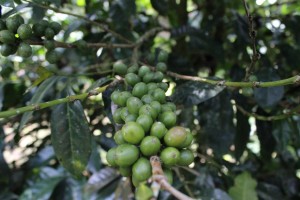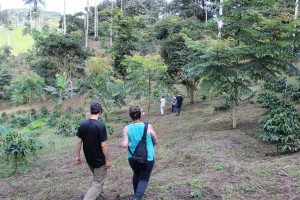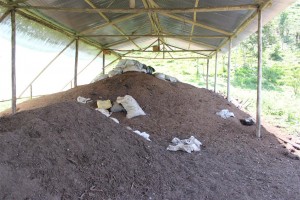Back
Ecuador – Day 3
Ecuador – Day 3
Well, I woke up at Sachatamia to the sun shining down in my room. Man, I wish I could’ve stayed here for a couple days! This place was beautiful! After a cold shower (you
owe me one, Alex [@ravenspeaking]), we had a nice breakfast up at the lodge of omelets with ham. The guys there were nice enough to allow us to brew up some of Nico’s coffee on their little Bunn. Much better than the Robusta being served at Hotel Quito!
On the agenda for today was a couple more farm visits. We headed out near the little town of Tulipe, and pulled into a beautiful farm called Las Tolas, after the native burial mounds that can be found in the area. This farm is owned by Arnaud Causse, a guy whose family is also very heavily involved in the flower business in Ecuador. For Arnaud, coffee is a passion, one to which he hasn’t been able to devote as much time as he’d like. This was pretty evident in his farm, as I’ll explain.
First off, let me say that Arnaud’s farm is absolutely beautiful. The first thing that struck me was how well integrated into the existing environment the farm really is. You don’t really feel
so much like you’re walking onto a farm as you feel like you’re just walking through the woods. It reminded me in some ways of El Retiro, a Rainforest Alliance farm in Guatemala.
The farm is located at about 1700-1800 meters, making it ideal for growing super tasty coffee. Arnaud grows primarily Caturra, Pacamara, and Java, as well as a cultivar garden with some other exotic types. The altitude is evidenced by the
lack of coffee leaf rust, and the fact that the coffee trees were absolutely gorgeous. However, the trees weren’t really pruned, making it very difficult to harvest efficiently. So difficult, in fact, that Arnaud will only produce around 150 quintales (1 quintale equals 100 pounds of cherry), when he should be producing closer to 500-600 quintales. The quality of what he does produce should be excellent. He just could be producing much more of it! Arnaud does plan on devoting more time to his farm next year, and plans on building a larger wet mill to accommodate a larger crop. Here’s hoping!
Unfortunately, we weren’t able to cup any coffees from Las Tolas. Due to the high altitude, they hadn’t started their harvest yet. I’m looking forward to seeing a sample in the next couple months.
After hiking through the farm for a couple hours (which included some pretty spectacular views, including a waterfall), we headed back to Arnaud’s house for some farm-fresh lemonade, guava juice, and coffee. After spending time with Arnaud, talking about logistics, we headed out, ready to tackle the next farm.
So a little ways down the road from Las Tolas is another farm called Yumbada. Yumbada is a very new farm (2 years old), and about the same size as Las Tolas. It’s owned and managed by a guy named Christian Marlin, whose passion for coffee rivals that of the most intense baristas and roasters I know!
Yumbada is new enough that they will not produce a meaningful crop this year, but they expect a full harvest next year. Also, located at about 1700 meters, Christian cultivates primarily caturra, typica, and pacamara, as well as a hybrid that was given to him by Nestle (Nestle has a huge presence in Ecuador, and is working on developing multiple
hybrids in hope of finding a cultivar that resists rust, produces well, and cups out well). Since there wasn’t really a harvest, we spent a lot of time talking about cultivation techniques, fertilizer, compost, etc. Christian really knew what he was talking about, and had a really great grasp of how agriculture works as a system, involving both microbial action and mineral inputs. Although he won’t be organically certified, I’d feel comfortable recommending his coffee to anyone. He only uses well-made fertilizers in appropriate amounts, and holds up the microbial end of the bargain by creating his own compost,
which consists of stone flour, sugar cane stalks, and chicken poop. Sounds weird, smells great, like fresh dirt.
Again, after hiking a bit through his farm (which was extremely well organized and kept), we ended up in his house, drinking soda and chatting. I’m really looking forward to seeing how his crop turns out next year. I have a feeling it’s going to be delicious, especially if he puts as much effort into the processing as he has the cultivation.
After finishing our sodas and saying our goodbyes, we headed off to lunch. We stopped at this little lunch place in Tulipe, no more than a single room restaurant with a few tables out front. This might have been my favorite meal of the
trip, highlighted by an expertly fried whole trout. Holy crap was this thing good. I’m pretty sure I left absolutely no meat on the bones.
After finishing lunch, it was time to head back to Quito. We had work to do! We weren’t really pleased with the roasting of the samples we cupped on Thursday, so we decided to take matters into our own hands, and roast them ourselves! We got back to Cafe Velez, fired up their electric sample roaster, and Andrew from Blueprint Coffee in St. Louis got to work. We picked out the 9 highest scoring sample from Thursday, ordered a couple of big pizzas and a 6-pack of beer, and pretty much watched Andrew roast for a couple hours. A special thanks to him for his dedication!
After letting the roaster cool for a bit, we packed up our stuff, and headed back to Hotel Quito to get some shut-eye.
-Dave











